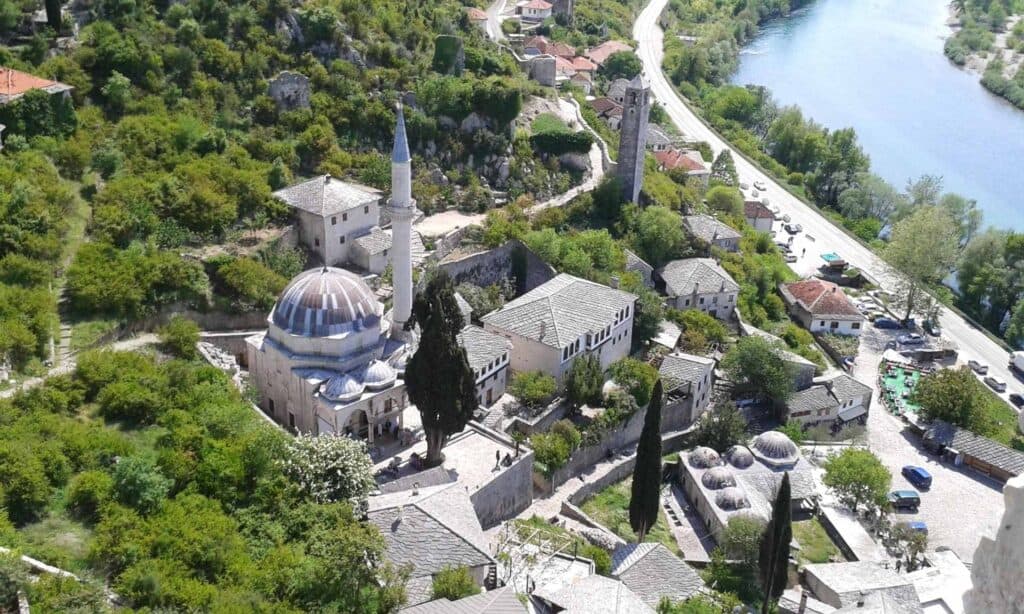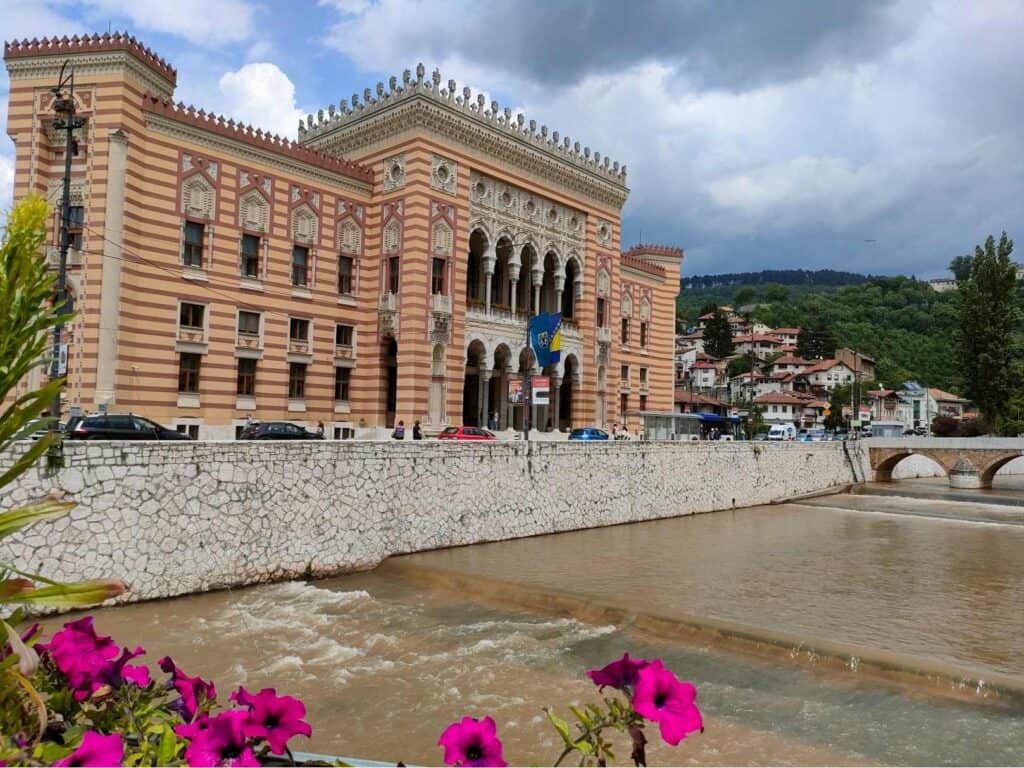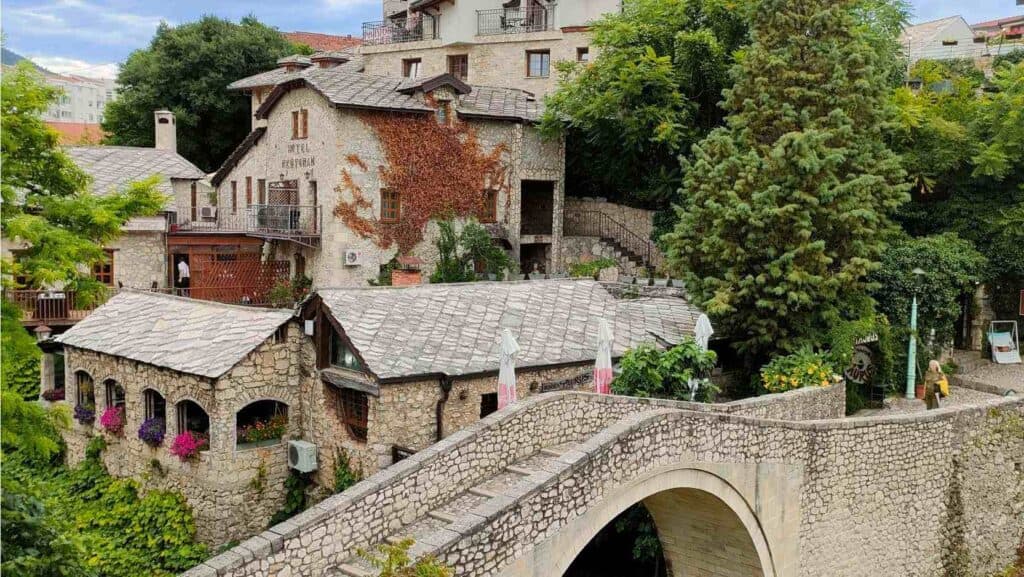This article may contain affiliate / compensated links. For full information, please see our disclaimer here.
Apart from spending a day visiting Mostar, you can make it your base for several wonderful day trips. Here is the list of things you can do on a day trip from Mostar, either with a rented car independently or with an organized private or group tour.
1. Kravice waterfalls, Počitelj, Blagaj
Visiting the Kravice waterfalls, Počitelj, Blagaj is the most popular day trip from Mostar. However, you can take your time and only pick the ones you are especially interested in.
The best way to complete all in one day if you don’t have a car is to go an organized tour since public transport is not frequent and will probably cost more after having to take a taxi occasionally.
I want to call your attention to a tour that apart from Kravice waterfalls, Počitelj, Blagaj also includes a stop at a new attraction of Mostar: the Skywalk in Fortica park. The transparent 35-meter-long structure offers a great panorama to Mostar.
Kravice waterfalls
The 25 cascades stretching across 100 meters of hills are called the “mini-Niagara” of Bosnia and Herzegovina. It is possible to swim in the natural pool in front of the waterfalls in summer, stroll around and go to one of the small restaurants or bring your own food and have a picnic. It is one of the most beautiful nature attractions in the country. It gets crowded in summer, and people come to spend the day here.
There are some activities on the spot: kayaking, taking a boat ride, or taking a 20-minute walk to the smaller waterfall, Mala Kravice.
Entrance fee: 20 KM (10 EUR)
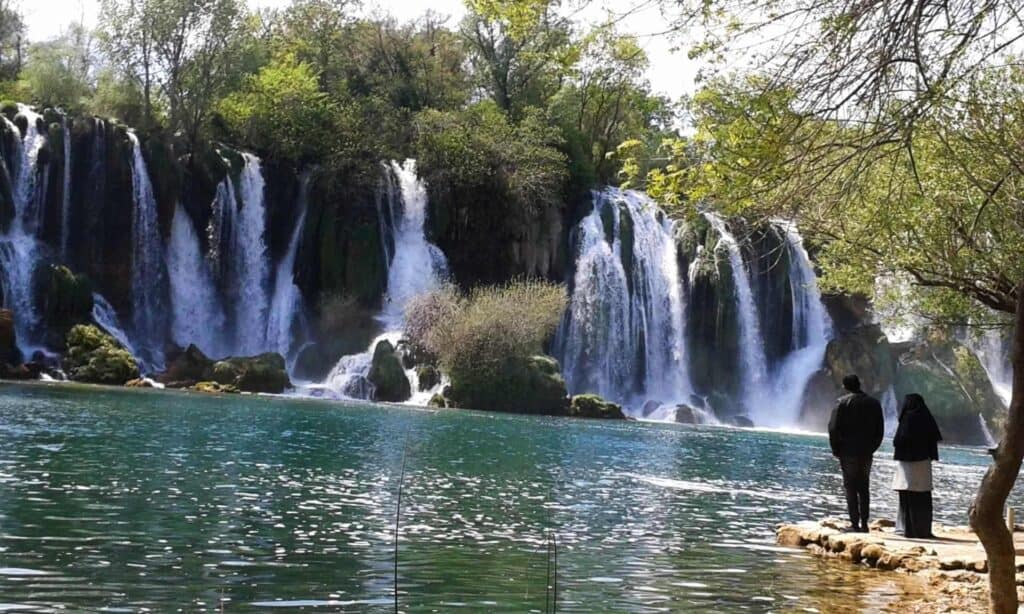
How to get there?
The Kravice waterfalls are 40 km from Mostar, but it takes one hour to get there through the winding road. There is no public transport, so the best way to get there is by car or on an organized tour.
Ultimate travel guide to Bosnia and Herzegovina
Počitelj
Around 25 km south of Mostar along the road to the sea is Počitelj, this little gem that is a must-see around Mostar. In this Ottoman-style town, the best thing to do is to stroll around the small streets and have a coffee on one of the terraces. To get the best view of the village and the Neretva River, climb to the fort atop the hill.
Other attractions of the village are Dadži-Alija Mosque, Sisman-Ibrahim Pasha’s madrasa, and the Gavran Kapetanović House.
How to spend one day in Mostar
Počitelj lost its strategic importance during the Austro-Hungarian rule it previously enjoyed under the Ottoman Turks. However, it is thanks to its abandonment that its medieval architecture could be preserved until now. During the Bosnian war, the village was heavily damaged, and the residents had to leave. Since then, the monuments and the residential buildings have been restored, and many people returned.
Blagaj
Blagaj is a small village only 15 km from Mostar with a unique atmosphere.
The main attraction, the historical tekke (Dervish monastery), was built in the 16th century during Ottoman rule with mosques and madrasas at the source of the Buna River that later joins the much bigger Neretva. The Dervish are followers of Sufism, a mystical, spiritual branch of Islam. In Turkey, the whirling Dervish are well known for using it in their worship and meditation.
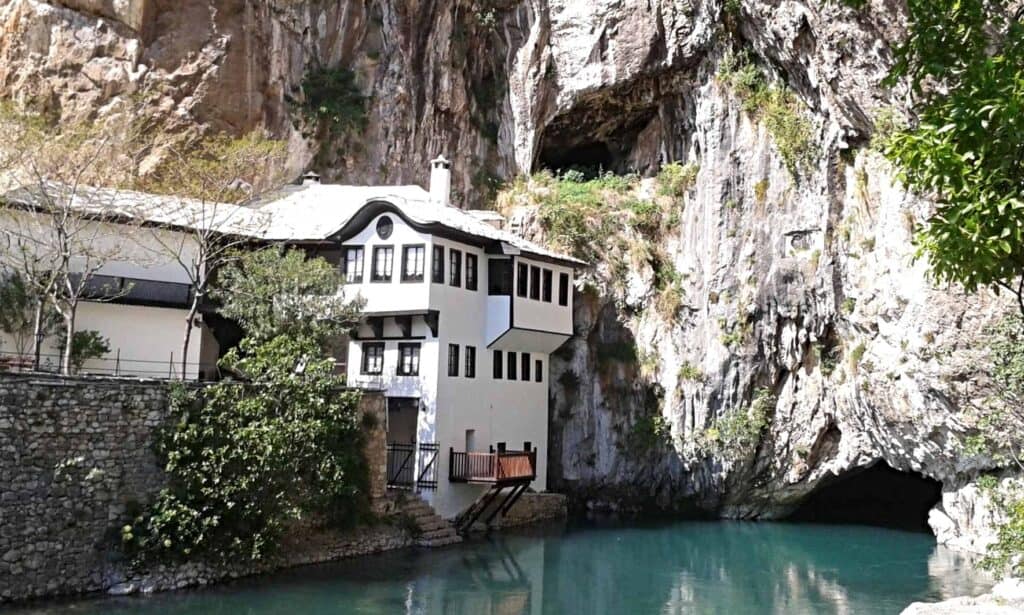
The tekke was built next to the water as it is considered a spiritual element. Dervishes have lived there for centuries. It was temporarily abandoned during the Yugoslavian times, but it returned in the 1980s.
The monastery has a picturesque location at the foot of a massive cliff wall along the river, where there are a couple of restaurants to finish your visit.
You get the best view of the monastery by crossing the bridge.
Entrance fee: 10 KM (5 EUR)
You must remove your shoes to visit the tekke and wear a scarf. If you don’t have one, you will get on the spot.
It is possible to take a boat (4KM~2 EUR) to go to the cave and see where the Buna river emerges.
Finally, climb up to the Blagaj Fort (which takes approximately 20 minutes) for the stunning view.
How to get there?
Buses 11 and 12 leave from Spanish Square to Mostar, and it takes half an hour to get there. Always check it before, as weekdays and weekends are different.
The other option is to take a taxi for approximately 20 KM (10 EUR).
The third and probably best option is to combine it with the Kravice waterfalls and Počiitelj on an organized tour.
2. Medjugorje
Visiting Medjugorje is one of the best day trips from Mostar. There are several hotels in the center of Medjugorje near St. James Church if you want to stay overnight.
How to get there?
Medjugorje is 25 km from Mostar, around half an hour’s drive. There are more buses during weekdays when children go to school; however, public transport is almost nonexistent at the weekend. There is one bus at the weekend that departs somewhere in the morning. Remember to double-check at the station to be sure.
It makes it more complicated that Mostar has two bus stations, one on the Bosniak and one on the Croatian side, and both have buses to Medjugorje. Unfortunately, they don’t have any information about the bus timetables of the other station.
A taxi to Medjugorje from Mostar costs around 25 EUR.
Or go on an organized tour to visit Medjugorje.
A constantly ascending winding road with a fantastic landscape takes you to a city inhabited mainly by Catholic Bosnian Croatians. Already for the location, it is worth the visit. Once, a poor Herzegovinian village became one of Europe’s biggest catholic pilgrimage sites.
Medjugorje owes its reputation to a miracle. Six teenagers claimed that on 24th June 1981, the Holy Virgin appeared and spoke to them. Now yearly, 1 million pilgrims come hoping to catch a glimpse of the Virgin Mary at the place where the miracle happened on the hill, which is now called “the Apparition Hill“. A rocky unpaved path leads up to the spot where the statue of the Virgin Mary stands. Despite not being easy terrain, many old and sick people also complete it.
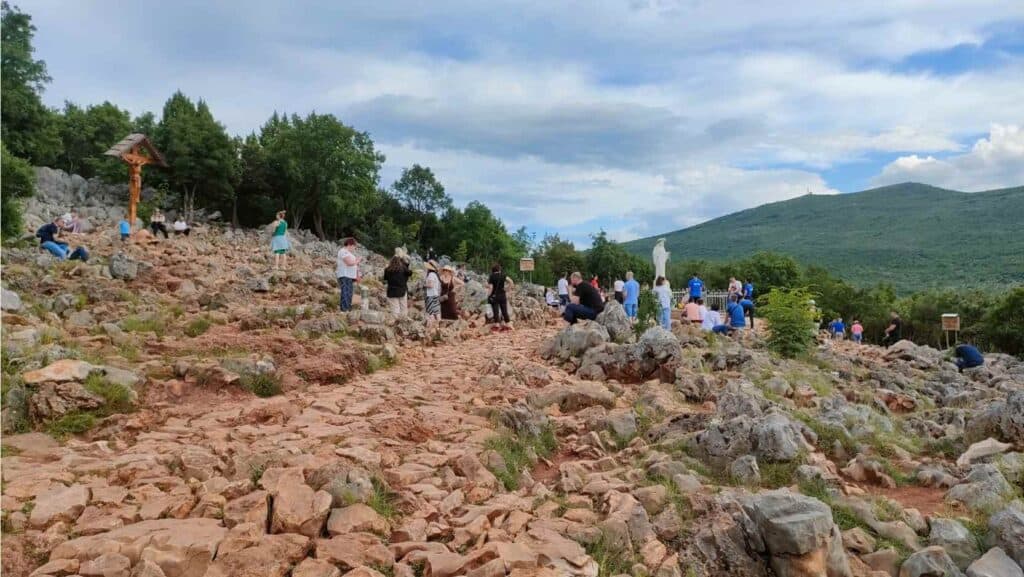
Pilgrims often pray while walking; some complete it barefoot. Once you get to the statue on the top, even if you are not religious, you probably get emotional seeing the people kneeling and silently praying around. There is something special up there that is hard to describe.
Devotees arrive from many countries, most with organized tours, and stay overnight to attend the open-air sermon behind the church.
From Apparition Hill, you can take a path directly to the city center, where most hotels and the St.James Church are located.
Behind the church, a little path for around 200 meters will lead to the Resurrected Saviour, also known as the Weeping Knee Statue. It is because some liquid is continuously leaking from the knee of Jesus that pilgrims take it as a miracle. They queue up to touch it, kiss it, and pray at the statue.
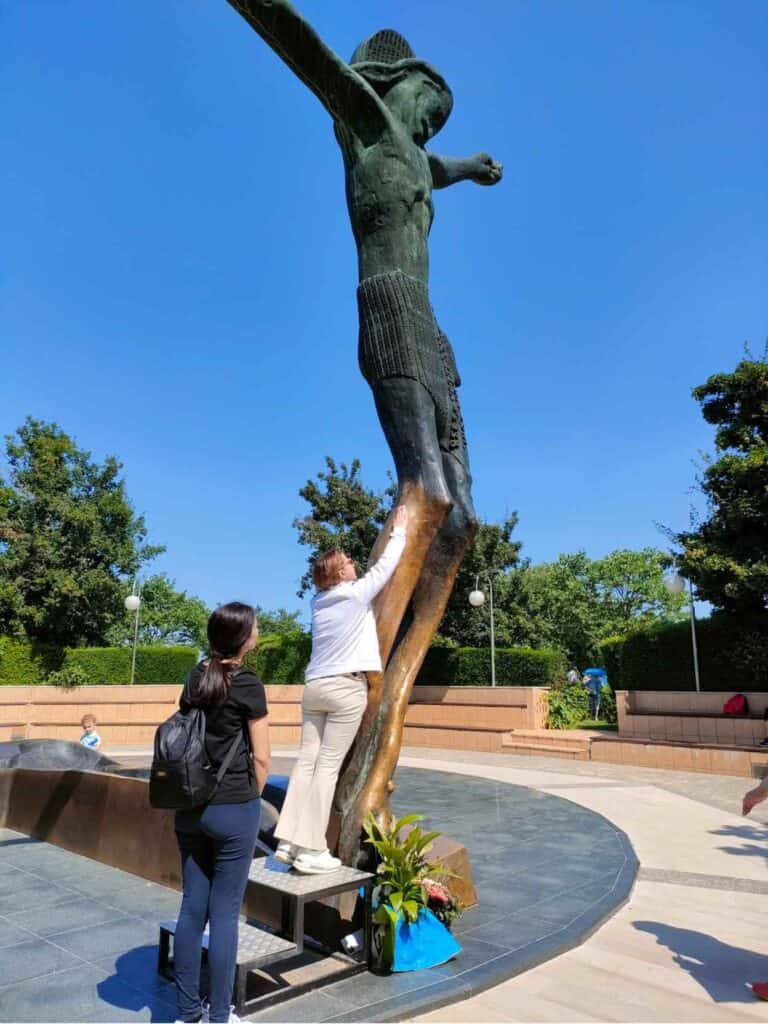
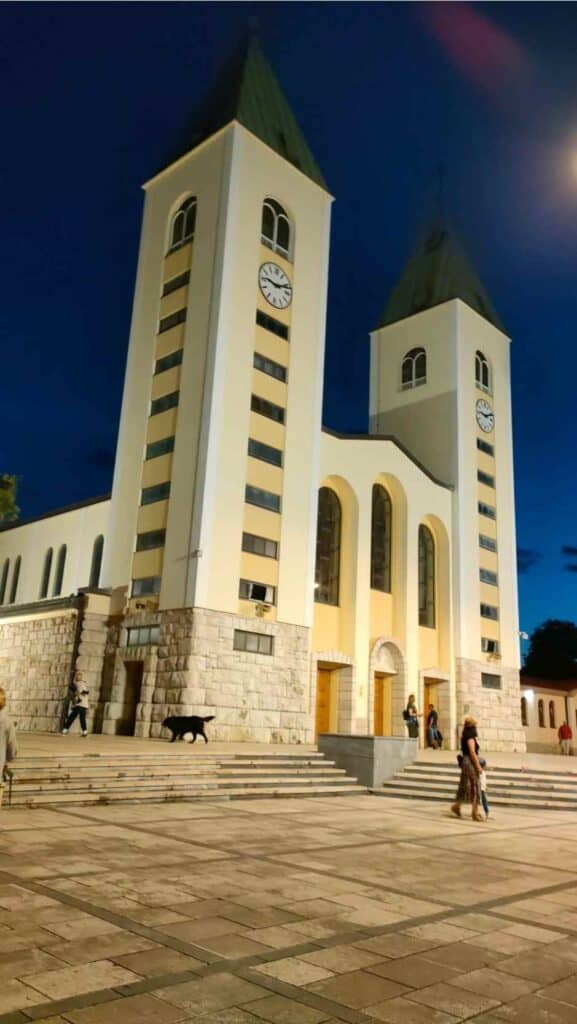
The city has one street packed with souvenir shops selling everything from holy water to fluorescent rosaries, cross-adorned raincoats, and small and large statues. All that can seem to be kitsch.
Medjugorje was saved from the war; some say because of the divine protection, but probably because it was an almost entirely Croatian territory.
The busiest time when it may be hard to find accommodation is Easter, the Assumption of the Virgin (15th August), and the Nativity of the Virgin (the first Sunday after 8th September).
If you want to get the feeling of Medjugorje, you should spend the night there.
3. Neum, the Bosnian beach
Take a day trip to the only coastal city of Bosnia and Herzegovina, Neum, at the Adriatic Sea. There is no cultural attraction; it is really about relaxing on the beach and a perfect opportunity to try seafood or drink a cocktail in the Skybar. The seaside path offers a pleasant walk with stunning views of the beaches and coastline, plus the Pelješac Bridge that was constructed in July 2022 in Croatia, thus avoiding a Bosnian enclave. The Bosnian beach is still popular for its more affordable prices.
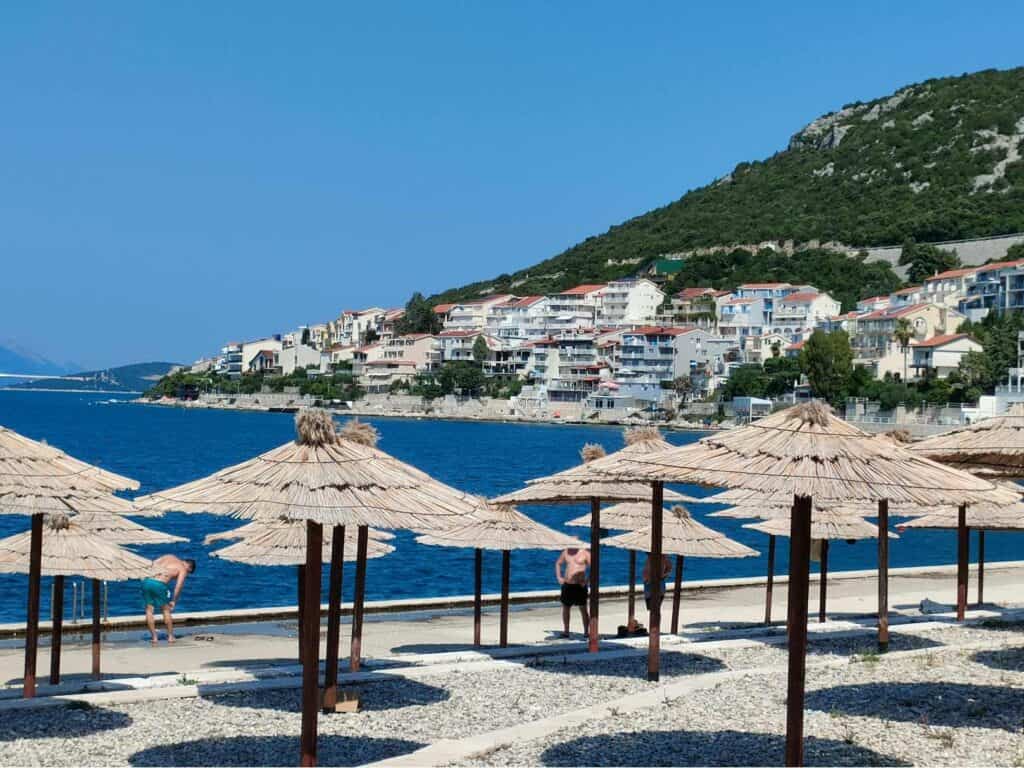
4. Trebinje
Trebinje, in the southernmost part of the country, only 30 km from Dubrovnik, is one of the most beautiful cities in Bosnia and Herzegovina. The road leading to Trebinje is gorgeous, passing by lakes and mountains. This way, you also get an idea about Republika Srpska, the Bosnian Serb Republic, as Trebinje is part of it. You notice that the Latin alphabet is replaced by Cirill letters here. (Since the end of the war in 1995, the country has been divided into two parts: the Federation of Bosnia and Herzegovina and Republika Srpska).
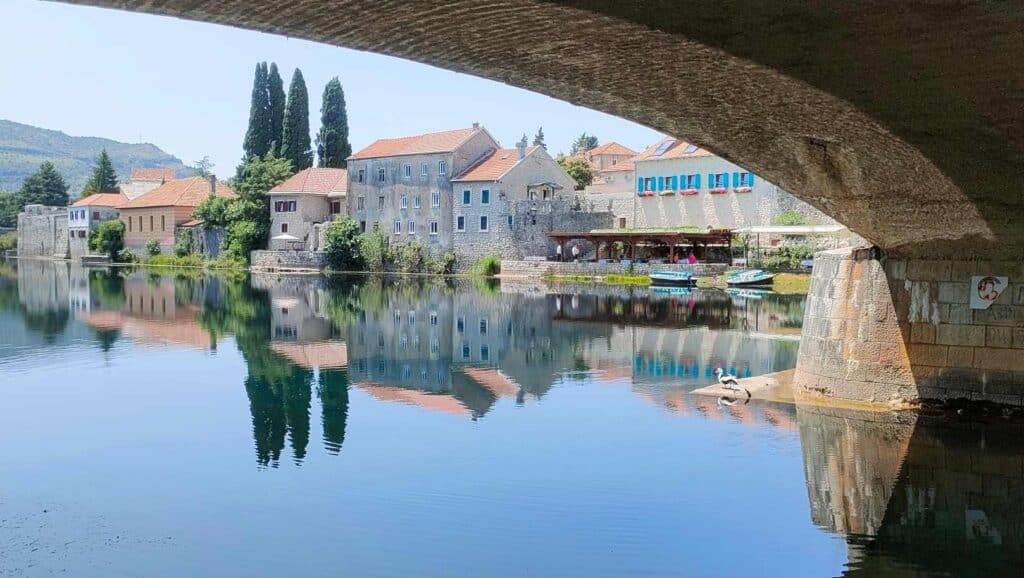
One of Trebinje’s most important attractions is the Arslanagića bridge over the Trebišnjica river, built in the Ottoman times in the 16th century. Another is the Hercegovačka Gračanica Serbian Orthodox Monastery, with a stunning view overlooking the city. The interior is decorated with colorful frescos. A few kilometers from Trebinje, the Tvrdoš monastery from the 16th century is another place to check out. Trebinje also has an old city; you can enjoy a meal in a riverside restaurant and return to Mostar at the end of the day.
How to get to Trebinje by public transport?
It is a bit tiring to use public transport as it one way takes almost 3 hours, but possible in a day. Otherwise, you can stay one night in Trebinje and return the next day.
There is a bus at 7:30 am that arrives in Trebinje at 10:15. From Trebinje, the bus departs at 17:30 and arrives in Mostar at 21:00.
You can also continue to Dubrovnik, just 45 minutes away, and buses depart at 09:55 or 19:10.
5. Tito’s bunker in Konjic – a must-see in Bosnia-Herzegovina
The military bunker of Tito, the former president of Yugoslavia, was the largest secret base in Yugoslavia that is now open to the public. It is a unique experience that you shouldn’t miss. The bunker, invisible from the outside, was built 280 meters below the mountain.
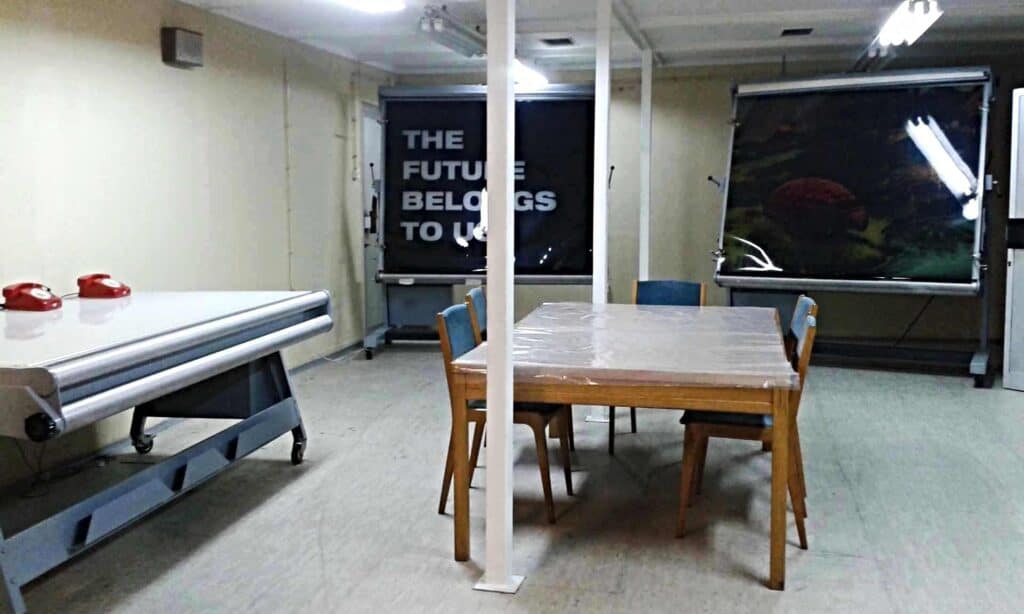
The entry to the extraordinary establishment is through an ordinary family house. You will be shocked about all they created there: telecommunications systems, kitchens, air conditioning, a generator, etc. In the event of a power failure, they would have been able to switch on the backup generators within 8 seconds. In the event of a fire, the cold shower could have been activated automatically within 18 seconds. There were even precise plans for air circulation. All these facilities allowed the communist elite, 350 leading politicians, to stay safe and rule the country for up to six months during a nuclear attack.
6. Day trip from Mostar to Sarajevo
Although Sarajevo deserves more than a day trip, and the best way to enjoy it is to stay overnight, you may have different plans. In this case, you can make a day trip from Mostar to Sarajevo and visit the highlight.
Sarajevo one day, 2 days, 3 days itinerary
With public transport
Take the early train to Sarajevo at 6:36 and take a bus back to Mostar, departing at 18:00 or 19:55.
Take an organized tour
This is the best way to make the most of your day trip from Mostar to Sarajevo with a guide who also gives you an explanation, and you can get to places that would not be possible alone or would take more time and cost much more.
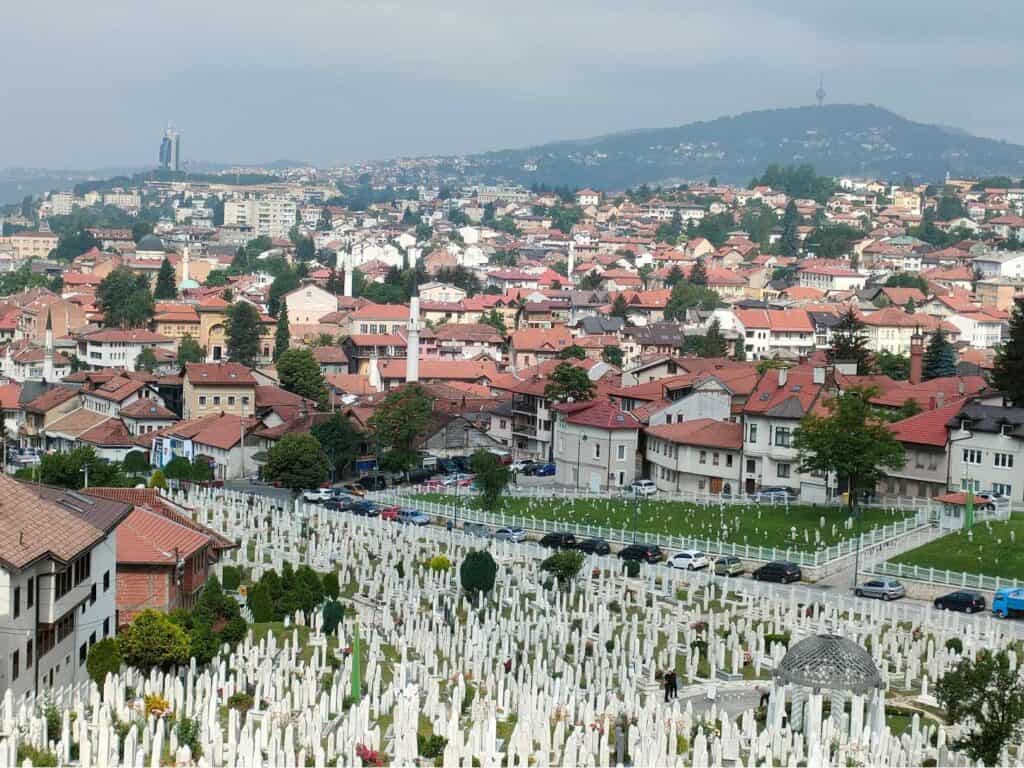
This comprehensive day trip includes a visit to the “Tunnel of Hope,” the tunnel built by the Bosnian Army to deliver humanitarian aid, food, and war supply to the besieged city during the war. You can also enjoy the view from Trebevič mountain and see the Olympic bobsleigh track. Stroll around the old town from the Ottoman and Austro-Hungarian periods and see the second-largest Jewish cemetery in Europe.
7. Kayak Safari on the Neretva River
If you are looking to spend the day in nature, that is what Bosnia and Herzegovina are famous for; you go on a kayak tour on the Neretva River where along the rocky canyon topped by the Prenj and Čvrsnica peaks. After one and a half hours of paddling, you reach the beach, where you can picnic and swim. After that, you return the same way. In between, you can jump from rocks and try Jablanica’s famous lamb.
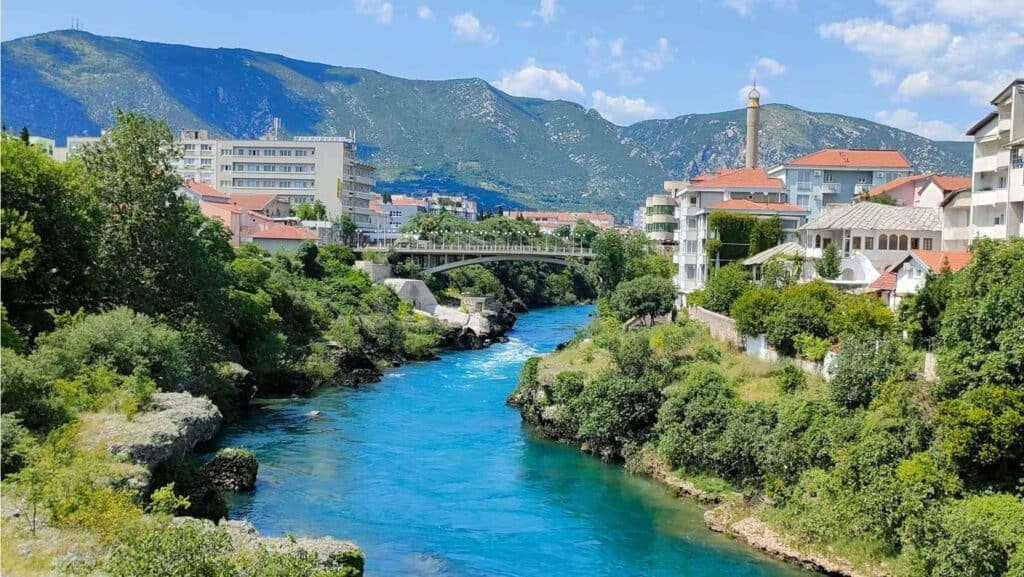
8. Wine Tour of Herzegovina
Are you interested in learning about the wine-growing tradition of Herzegovina and tasting some of the best wines? There is a tour to visit the two main wine-growing regions with two wineries (Wine Zadro & Winery Brkić). You also get to taste traditional meza, different kinds of dried meat and cheese.
If you are interested in wine, this is a tour for you!
Ultimate travel guide to Bosnia and Herzegovina
9. Visit the gems of Herzegovina
Mostar is the center of Herzegovina, but you may want to see more of the countryside. This tour takes you to Blagaj, the Dervish monastery by the Buna River, and of Orthodox monastery in Zitomislici, near Mostar, one of Herzegovina’s most important religious and cultural centers during the Ottoman times. Like other orthodox churches, colorful frescos adorn the interior. Finally, you get to see the Radimlja Necropolis, which reveals Bosnia and Herzegivina’s medieval history and is a UNESCO World Heritage site. It contains over 100 stećci (tombstones), mainly from the 1480s through the 16th century, with artistic drawings and inscriptions.
It is one of the few attractions that give insight into the medieval times when the Bosnian Kingdom existed.
10. Full-day hiking Cvrsnica Hajducka Vrata
Are you interested in hiking in the heart of the Dinaric mountains to enjoy the incredible landscape? The Blidinje Nature Park offers excellent hiking trails among mountains, karst fields, valleys, and lakes. Check the details about full-day hiking here.
As you can see, there are several places to visit from Mostar on a day trip, depending on your interest, making it a perfect base for travels around Bosnia and Herzegovina. The country is much more than Mostar and Sarajevo. Getting to know the countryside, small towns, and historical and cultural places gives you a better understanding of the country.
How to plan your trip to Bosnia and Herzegovina
Flight: Find the cheapest flights to Bosnia and Herzegovina with Skyscanner or book flights, hotels, and local tours, rent a car, and benefit from immediate cashback through Wayaway! You can sign up for the Wayaway Membership program for only 49.99$! Use my discount code to get extra 10% off the subscription fee: VOG
Accommodation: Book hostels through hostelworld.com or look for both hostels and hotels in Bosnia and Herzegovina on booking.com.
Local tours: Book walking tours in tours in Sarajevo, Mostar and other one or multi-day trips in Bosnia-Herzegovina through GetYourGuide or Viator
Rent a car: Find a great deal to rent a car with Discover Cars or Rentalcars.
Bus ticket: Book your bus ticket through Bookaway in Bosnia and Herzegovina.

